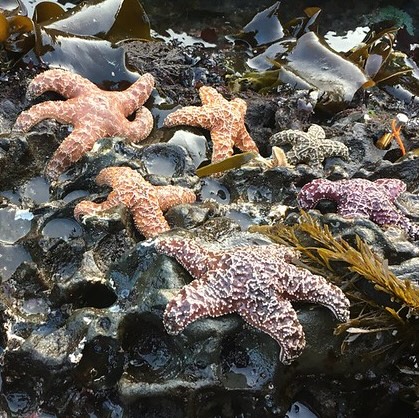Science
Ochre Sea Stars Surge Back from Near Extinction on Oregon Coast

Research from scientists at Oregon State University and Cal Poly San Luis Obispo reveals that a significant increase in ochre sea stars is aiding the species’ recovery along the Oregon Coast. This resurgence follows a severe population decline caused by a wasting disease that nearly led to their extinction a decade ago. The findings, published in the journal Ecosphere, highlight encouraging trends in ochre sea star populations, although the exact reasons behind this rebound remain uncertain.
The study, led by Sarah Gravem, who is currently an assistant professor at Cal Poly, alongside Bruce Menge, a distinguished professor at OSU, analyzed sea star populations across eight locations over a span of 23 years. They found that many of the “baby boomers” have reached adulthood, with population numbers now at or exceeding levels seen before the wasting disease outbreak.
“After declines in sea star numbers of up to 84% in 2014, we quickly saw an 8,000% increase in young sea stars landing on shore,” Gravem stated. The research indicates that the population is recovering sufficiently to resume its role as a keystone predator in the intertidal zone. At three-quarters of the study sites, predation on their primary prey, California mussels, has rebounded.
The recovery of ochre sea stars is pivotal as their predation opens up space for various other species to thrive. “We showed that sea stars have now grown abundant and large enough that they are eating mussels at similar rates to before the epidemic at most sites in Oregon,” Menge noted. This is crucial since mussels, when unchecked, can dominate intertidal environments, hindering the growth of other invertebrates and seaweeds.
Despite the positive trends, challenges remain. The average body sizes of the sea stars are still approximately 25% to 65% smaller than pre-epidemic sizes at all but one location. Additionally, the sea star populations across the coast are exhibiting greater fluctuations from year to year compared to before the epidemic, suggesting that recovery is not yet fully stabilized.
The researchers point out that ongoing fluctuations in population levels may be attributed to continuous recruitment of young sea stars and sporadic outbreaks of the wasting disease. “The connection between the sudden decline of ochre sea stars and the baby boom remains elusive,” Gravem explained. There is a possibility that the two events are linked, which might indicate that these sea stars possess resilience against mass mortality events. Alternatively, the baby boom could simply be a stroke of luck that facilitated a relatively rapid recovery.
Wasting disease causes sea stars to develop lesions and distorted arms, leading to the appearance of melting. The bacterium responsible for this condition, Vibrio pectenicida, was identified through collaborative research involving scientists from the University of British Columbia, the University of Washington, the U.S. Geological Survey, and the Hakai Institute.
The recovery of the ochre sea star population on the Oregon Coast serves as a hopeful indicator of marine resilience and ecosystem health, underscoring the importance of continued monitoring and research into marine life and environmental changes.
-

 Business2 weeks ago
Business2 weeks agoIconic Sand Dollar Social Club Listed for $3 Million in Folly Beach
-

 Politics2 weeks ago
Politics2 weeks agoAfghan Refugee Detained by ICE After Asylum Hearing in New York
-

 Health2 weeks ago
Health2 weeks agoPeptilogics Secures $78 Million to Combat Prosthetic Joint Infections
-

 Science2 weeks ago
Science2 weeks agoResearchers Achieve Fastest Genome Sequencing in Under Four Hours
-

 Lifestyle2 weeks ago
Lifestyle2 weeks agoJump for Good: San Clemente Pier Fundraiser Allows Legal Leaps
-

 Health2 weeks ago
Health2 weeks agoResearcher Uncovers Zika Virus Pathway to Placenta Using Nanotubes
-

 World2 weeks ago
World2 weeks agoUS Passport Ranks Drop Out of Top 10 for First Time Ever
-

 Business2 weeks ago
Business2 weeks agoSan Jose High-Rise Faces Foreclosure Over $182.5 Million Loan
-

 World2 weeks ago
World2 weeks agoRegional Pilots’ Salaries Surge to Six Figures in 2025
-

 Science2 weeks ago
Science2 weeks agoMars Observed: Detailed Imaging Reveals Dust Avalanche Dynamics
-

 Entertainment2 weeks ago
Entertainment2 weeks agoJennifer Lopez Addresses A-Rod Split in Candid Interview
-

 Top Stories2 weeks ago
Top Stories2 weeks agoChicago Symphony Orchestra Dazzles with Berlioz Under Mäkelä








